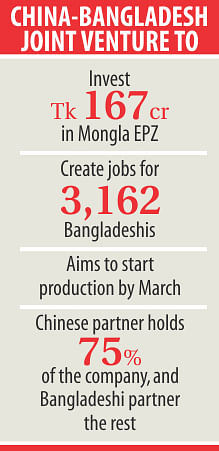$21.5m leather plant at Mongla EPZ
$21.5m leather plant at Mongla EPZ

A new export-oriented leather company, Rich Time Enterprise, is gearing to start operations in March to grab a share of the fast expanding global leather and footwear market.
Bangladesh is a promising place for the leather industry thanks to its abundance of raw materials and cheap labour, said Md Suzan, managing director of Rich Time Enterprise.
The company, a China-Bangladesh joint venture, is currently importing machineries for its 20,000 square feet-plant at Mongla Export Processing Zone.
The plant will cost $21.5 million (Tk 167 crore), which is the biggest investment proposal in the EPZ, and will have an annual production capacity of five million square feet of finished leather, two lakh pieces of bags and one lakh pairs of shoes.
It will create jobs for 3,162 Bangladeshi nationals, said Suzan, who also has a telecom trading business of his own.
While full-fledged operations will start in a year, the company aims to start production of crushed leather in two months, Suzan said, adding that the products will be exported to the US, Japan, Korea, Taiwan and some European countries.
Rich Time Enterprise of Hong Kong will hold a 75 percent stake in the venture, while local Asian Trading Company the rest. Suzan, who has around 15 years of experience in leather trading, said many foreign companies are interested in setting up leather factories in the country due to the high quality of leather.
China produces around $90 billion of footwear and $39 billion of leather goods, which account for 65 percent and 35 percent of the global demand respectively, according to industry people.
But it is also facing a number of challenges such as anti-dumping tax imposed by the European Union, strengthening of renminbi against the dollar. As a result, China's leather industry is now shifting to Bangladesh, Vietnam, Cambodia, Pakistan, India and Myanmar.
The leather industry in the past three decades has transformed itself from the low value-addition tanning activity to a producer of leather footwear and leather goods along with the high value-added crust and finished leather, according to experts.
Bangladesh exported $662.88 million of leather and leather goods between July and December, up 6.85 percent year-on-year, according to the Export Promotion Bureau. The sector's exports rose 32.12 percent year-on-year to a record $1.29 billion last fiscal year.
Of the total exports from the leather industry, 60 percent go to the European Union, 30 percent to Japan and 10 percent to the rest of the world, according to industry insiders. The industry, which has grown on local raw materials, has now emerged as the second largest export earner after garments.
As of November, Mongla EPZ has a total of 29 companies, 16 of which are in operation and the rest under construction. It has received a total of $15.64 million of investment and employs 1,603, according to data from the Bangladesh Export Processing Zones Authority.
BEPZA accounted for 18.30 percent of the country's total exports of $30.17 billion in fiscal 2013-14.
suman.saha@thedailystar.net